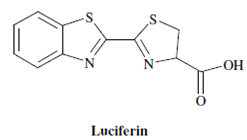Bioluminescence phenomenon:
The reactions include in the process of bioluminescence are given below.
LH2 + E + ATP + Mg2+ → E-LH2 AMP + Mg Ppi
E-LH2 AMP + O2 → AMP + CO2 + H2O + Oxyluciferrin*
Oxyleuciferrin* → Oxyluciferrin + hυ
In above example E = enzyme luciferase, LH2 = substrate luciferin, AMP = adenosine monophophate and PPi = pyrophosphate. The oxyleuciferrin -a fluorencent radiating compound is generated due to enzyme reaction. ATP can be indirectly analysed.
Within the first step the firefly enzyme luciferase catalyses the creation of a complex among luciferin and ATP. The complex is known as luciferyl adenylate is oxidised through oxygen, leading to the production of cyclic peroxide in which eventually becomes high- energy oxyluciferin. The oxyluciferin in an excited state relaxes back to the ground state, accompanied through the emission of light.

The light output is straight proportional to the concentration of the limiting reactant in the system. Within the ATP/ luciferin-luciferase system, while the total sample volume is held constant and ATP is the limiting reactant, the light result is proportional to the ATP concentration. While luciferase is the limiting reactant, the light result is found to be proportional to the luciferase concentration.
The Bioluminescence phenomenon is being exploited for research within the medical field. Certain bioluminescent bacteria are being used to follow the progression of infection within mice. The spread of infection can be gauged and the effect of various antibiotics could be followed visually. Further, the bioluminescent organisms are being used to trace the ATP and calcium within the cell, and to assist in AIDS research besides other applications.